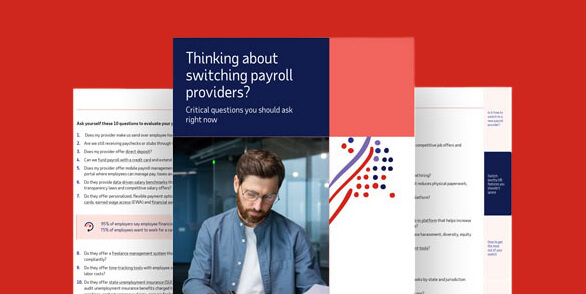insight
How to set up a 401k: A guide for employers
Interested in offering a retirement plan to your employees?
The decision to set up a 401k is a worthy one for many businesses. It can help employers attract and retain talent, improve employee financial wellness, and save for their own retirement. When done correctly, setting up a 401k may also be tax advantageous.
Table of Contents
What is a 401k?
A 401k is a retirement savings plan funded primarily by employees with pretax earned wages. Employers have the option to contribute to their employees’ plans, thereby maximizing the full savings potential.
How do 401k plans work?
Employees who are enrolled in a 401k contribute to their retirement savings plan via pretax payroll deductions. Further functionality largely depends on plan design.
Traditional 401k
Business owners who offer a traditional 401k have the flexibility to contribute the same amount to all participating employees, match individual contribution rates, do both or not contribute at all. These contributions aren’t vested until a certain amount of time has lapsed. Two of the vesting schedules permitted by the Internal Revenue Code (IRC) are:
- 100% vested after three years of service
- 20% vested after two years of service, followed by an additional 20% each year until employer contributions are 100% vested in year six
Traditional 401k plans are also subject to annual testing to ensure that they don’t disproportionately favor certain participants over others, i.e., highly-paid executives vs. average employees.
Safe Harbor 401k
Employers can avoid annual nondiscrimination testing by designing their 401k as a Safe Harbor plan. The trade-off is that they’re required to contribute to their employees’ plans, either via matching or non-elective contributions. Contributions are also fully vested at the time they are made.
Automatic 401k
An automatic 401k is an ideal option for employers who want to increase plan participation. As the name implies, employees are automatically enrolled at a default contribution rate unless they specifically opt out or change the rate.
What are the benefits of offering a 401k to employees?
Helping employees plan for the future is a big responsibility, but it can also be very rewarding. Employers who offer a 401k may be able to:
Attract and retain talent
In addition to competitive salaries and health benefits, retirement savings plans can be a major influencer with candidates who are weighing different job offers.
Improve retirement readiness
Employees who are financially prepared for retirement can leave the workforce when the time is right, thereby creating growth opportunities for other employees and new talent.
Take advantage of tax savings
Businesses that sponsor a 401k are potentially eligible for a $500 tax credit to cover startup administration costs during the first three years of the plan. Additional tax deductions may be available if the employer matches employee contributions.
Enhance productivity through financial wellness
A retirement savings plan is one of the cornerstones of financial wellness. And when employees feel secure about their future, they tend to be less stressed and more productive at work.
Explore See how you can make retirement plan administration easy
What are the benefits of a 401k compared to other retirement options?
Compared to simplified employee pension individual retirement accounts (SEP IRAs) and savings incentive match plans for employees (SIMPLE IRAs), 401k plans have higher annual contribution limits. Thus, employees may be able to save more money in a shorter amount of time with a 401k, making it ideal for those who are older and short of their savings goals. It also allows employees to borrow money from their retirement savings accounts. SEP IRA and SIMPLE IRA plans do not.

Take advantage of increased tax incentives
See how your business can benefit from recent changes in regulations.
What is a SIMPLE IRA?
A SIMPLE IRA is a retirement savings plan designed for small businesses, particularly those with less than 10 employees. As such, it’s typically low cost and easy to set up and administer. Employees who participate in a SIMPLE IRA can defer a percentage of their salary to their savings account and their employer is required to either match it or make non-elective contributions.
What's the difference between a traditional 401k and a Roth IRA?
The primary difference between a 401k and a Roth IRA is how the savings are taxed. Contributions to a 401k are made before tax deductions, whereas those to a Roth IRA are made after tax deductions. When employees retire, their income from a 401k savings plan is subject to taxes. Qualified withdrawals from a Roth IRA, on the other hand, are tax free.
How to set up a 401k for a business
The path to a successful retirement savings program starts with plan design. And while it’s true that employers can set up 401ks on their own, it’s generally recommended to seek the help of a professional or a financial institution. They’ll provide expert guidance throughout each of the following steps:
- Draft a 401k policy document
Plan documents typically outline the type of 401k chosen – traditional, Safe Harbor or automatic – and key details, such as employee eligibility, contribution levels, etc. The process by which contributions are deposited into the plan and other essential functions may also need to be documented, per legal requirements. - Choose a trust to hold plan assets
At least one trustee must be chosen to manage plan contributions, investments and distributions. This decision is especially important because financial integrity, i.e., ensuring that assets are only used for the benefit of plan participants and their beneficiaries, depends upon it. - Establish recordkeeping methods
A record keeping system is necessary to keep track of contributions, investments, earnings and losses, expenses, and distributions. It also comes in handy at year’s end when 401k plan reports have to be filed with government agencies. - Provide information to eligible participants
Employers who sponsor a 401k are required to provide eligible participants with a summary plan description (SPD), as well as information regarding their rights and plan benefits and features. SPDs are usually written in conjunction with the plan document.

Financial wellness solutions — good for your team, good for your business
Drive engagement and help get your team on the path to lasting financial wellness.
How much does it cost to set up a 401k for small businesses?
The cost of setting up a 401k generally depends on business size, plan design and the extent to which employers make contributions. Employers must also consider the administrative fees of third-party fiduciaries who help manage the plan’s investments. Applying for certain tax credits, however, can help offset some of these costs.
Maintaining 401k plans for a business
Most 401k plans are subject to the requirements of the IRC and the Employee Retirement Income Security Act (ERISA), which provide minimum standards that protect individuals in retirement plans. Administering and maintaining plans that comply with these regulations ranges in difficulty from the moderate to the complex.
What is the role of the employer in administering 401k plans?
Under ERISA, plan fiduciaries, including the employer and any third parties who manage the plan and its assets, must act solely in the interest of the plan beneficiaries. Some of their responsibilities include:
- Managing the plan with the exclusive purpose of providing the plan’s retirement benefits to participants
- Ensuring that the investment menu offers a broad range of diversified investment alternatives
- Choosing and monitoring plan investment alternatives prudently
- Ensuring that the costs of plan administration and investment management are reasonable
- Filing reports, such as Form 5500 Annual Return/Report, with the federal government
These tasks should be taken seriously since fiduciaries can be held personally liable for plan losses or profits from improper use of plan assets that result from their actions.
How long does it take for a small business to set up a 401k?
A start-up 401k plan for a small business typically takes 30 to 45 days to implement, on average. Converting an existing plan from one financial provider to another may take as long as 60 to 65 days.
Questions to expect from 401k participants
Employees who are eligible for an employer-sponsored 401k inevitably will have questions about the plan. Here are some of the most common:
How much should an employer contribute to a 401k?
With a traditional 401k, employers have the flexibility to alter how much they will contribute to their employees’ retirement savings accounts from year to year. Safe Harbor plans, on the other hand, are a bit more restrictive and require one of the following:
- Match eligible employee contributions dollar for dollar up to 3% of compensation and 50 cents on the dollar for contributions that exceed 3%, but not 5% of compensation.
- Make non-elective contributions equal to 3% of compensation for all eligible employees.
In total, employer contributions to any type of 401k, combined with employee salary deferrals, cannot exceed the lesser of 100% of employee compensation or the IRS limit for that year.
How much should an employee contribute to a 401k?
How much an employee should invest in a 401k is a personal choice that may depend upon the individual’s age, income and retirement savings goals. Yet, there is one caveat – the IRS imposes an annual maximum on elective deferrals.
How do employers choose the best mutual funds to offer employees?
Managing investments is sometimes beyond the expertise of employers. That’s why many of them outsource the process of selecting, diversifying and monitoring plan investments to an investment advisor. Professional assistance helps ensure that the investment options are in the best interest of the plan and its participants.
What are the different types of 401k plans?
There are many different types of 401k plans, with the most common being a Traditional 401k, a Roth 401k and a Simple 401k. ADP lets business owners pick the retirement plan solutions that are ideal for their business and its unique needs. For instance, the ADP 401k Essential is most often the right choice for smaller businesses with up to 49 employees. ADP 401k Enhanced is recommended for businesses with 50 to 99 employees, while the ADP 401k Premier is most often selected by companies with over 100 employees. All of ADP’s plans have easy administration and the tools and resources to keep employees engaged.
Want more exclusive business insights like this delivered to your inbox?Subscribe now
This article is intended to be used as a starting point in analyzing 401k and is not a comprehensive resource of requirements. It offers practical information concerning the subject matter and is provided with the understanding that ADP is not rendering legal or tax advice or other professional services. ADP, Inc. and its affiliates do not offer investment, tax or legal advice to individuals. Nothing contained in this communication is intended to be, nor should be construed as, particularized advice or a recommendation or suggestion that you take or not take a particular action.
Unless otherwise agreed in writing with a client, ADP, Inc. and its affiliates (ADP) do not endorse or recommend specific investment companies or products, financial advisors or service providers; engage or compensate any financial advisor or firm for the provision of advice; offer financial, investment, tax or legal advice or management services; or serve in a fiduciary capacity with respect to retirement plans. All ADP companies identified are affiliated companies.
1. ZipRecruiter is a registered trademark of ZipRecruiter, Inc.
2. Legal services are provided by Upnetic Legal Services, a third-party provider





